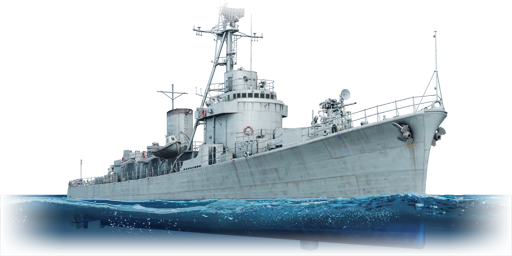



The Ikazuchi-class, JDS Ikazuchi (DE-202) (いかづち, namesake: Thunder) was a Japanese destroyer escort and the lead ship of her class. Laid down in 1954, she was among the first domestically built Japanese vessels after WWII, replacing earlier US lend-lease patrol vessels like the PF- and LSSL-types, which had kickstarted the Coastal Safety Force. By the time of Ikazuchi's introduction, this force had evolved into the Japan Maritime Self-Defense Force (JMSDF). Ikazuchi's design drew inspiration from US destroyer escorts, incorporating experience from Imperial Japanese coastal defence ships. Developed after Japan's first post-war DE, Akebono, Ikazuchi was slightly smaller but equipped with two high-output, medium-speed diesel engines. These engines, unlike steam turbines, required less space, required less engine crew, and offered better performance once initial defects were resolved. Originally armed with Type 54 3-inch "slow firing" guns (Mk.22), Ikazuchi received an upgrade in 1959 to Type 57 3-inch automatic guns (Mk.33), along with new sensors, as the original equipment had quickly become outdated after her 1956 introduction. Unlike Akebono, which had to sacrifice some depth charges to mount better guns, Ikazuchi was able to maintain her full ASW armament while upgrading her guns.
Ikazuchi was introduced in Update 1.97 "Viking Fury". She features relatively fast-firing 3-inch guns with a variety of shell options, including standard HE, HE-VT for anti-aircraft use, and APHE for armoured targets. As a destroyer escort, she does not carry torpedoes, as her primary roles were anti-submarine warfare (ASW) and coastal patrol. The ship's guns are strategically placed at both ends, providing nearly 360° coverage. This allows for excellent firing angles and the ability to execute evasive manoeuvres by swinging the ship from port to starboard without needing to completely reposition the guns.
| Ammunition | Type | Armor penetration (mm) at a distance: | |||||
|---|---|---|---|---|---|---|---|
| 100 m | 1000 m | 2000 m | 3000 m | 4000 m | 5000 m | ||
| HE | 11 | 10 | 8 | 8 | 8 | 8 | |
| APHE | 121 | 101 | 86 | 76 | 68 | 62 | |
| HE-VT | 12 | 10 | 9 | 8 | 7 | 7 | |
| Belt | Belt filling | Armor penetration (mm) at a distance: | |||||
|---|---|---|---|---|---|---|---|
| 10 m | 100 m | 500 m | 1000 m | 1500 m | 2000 m | ||
| AP-T/HEFI-T | 81 | 78 | 69 | 61 | 55 | 50 | |
| AP-T/AP-T/AP-T/HEFI-T | 81 | 78 | 69 | 61 | 55 | 50 | |
| HEFI-T/HEFI-T/HEFI-T/AP-T | 81 | 78 | 69 | 61 | 55 | 50 | |
24 × Mk.9 depth charge
40 × K-gun Mk.9 depth charge











Seakeeping |
|---|
Unsinkability | |
|---|---|
Firepower | ||
|---|---|---|